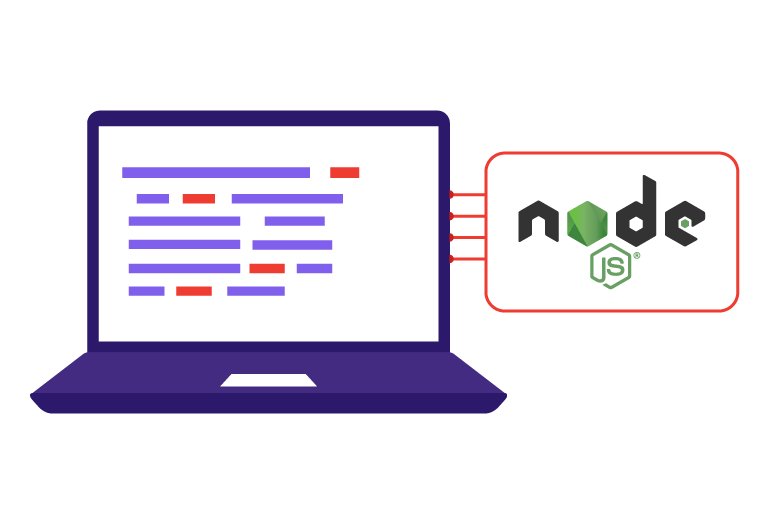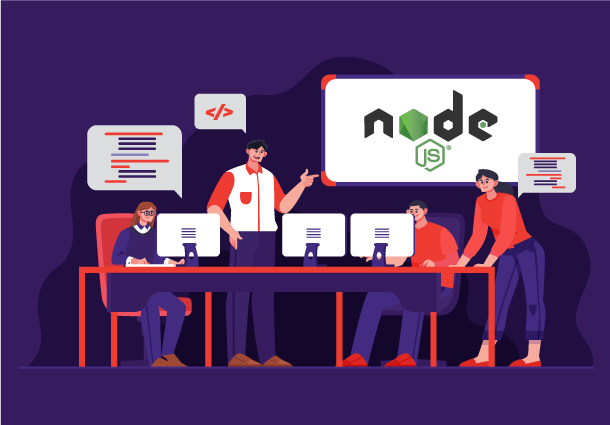Rounding off Node js web Application Framework
JavaScript and Node.js – Now, doesn’t that sound like pure magic? It goes without saying that JavaScript’s utility and popularity grew with time as one of the easiest programming languages to learn and work with. An even bigger thanks to the Node.js backend framework. Devs no longer have room for errors. With several lines of bug-free algorithms for both the front and back end, super-fast performance is guaranteed. So, now you’d want to know what makes Node.js a born optimist. So, today I’ve laid before you the nitty-gritty of this wonderful JavaScript tool. So what are you waiting for? Jump in!
Node.js and the Trail behind
What is Node.js? The straightforward answer to this question would be “Node.js® is a JavaScript runtime built on Chrome’s V8 JavaScript engine”. This is the definition proposed by the Nodejs team, well, what does this mean?
The core of this description can only be understood by going a little bit into the history of how Node js came to be.  So, let’s do a quick replay. If you’ve been a JavaScript geek for a long time, then you might know how it spent its early days working hard only as a client-side scripting language. But as JavaScript took over a serious role in defining the modern experience of the web, development teams had to go the extra mile to keep up with the competition.
So, let’s do a quick replay. If you’ve been a JavaScript geek for a long time, then you might know how it spent its early days working hard only as a client-side scripting language. But as JavaScript took over a serious role in defining the modern experience of the web, development teams had to go the extra mile to keep up with the competition.
The process that followed often tried to reduce the developer’s burden of moving between the front-end and back-end of a web app with different languages. As a result, the V8 JavaScript engine (the one that Node js uses) that powers browsers like Google Chrome was improved and took a leap into server-side development. Once Node.js came into the picture, it became possible to write event-driven, server-side, real-time applications that can run across shared devices.
A better definition to make things easy. “Node.js is the passionate server-side offshoot of JavaScript that was launched in 2009”. With the advent of the Node.js web application framework, JavaScript works as well as other scripting languages like Python. Therefore, you could possibly conclude that although Node js is only 11 years old, it was one of the biggest innovations that put JavaScript into a better perspective.
Node.js Architecture Explained
So, here we are at the technical forefront of the Node js web application framework. Let’s explore what’s up with the Node.js architecture that’s so praiseworthy.
- As discussed earlier it uses the V8 JavaScript engine along with a non-blocking I/O model making it lightweight and efficient. This feature makes JavaScript easily digestible in the form of machine language leading to better execution and super fast codes. Watch out! Here the code operates in the server-to-client direction with the non-blocking I/O keeping it steady and secure.
- Node js handles concurrent requests using a single-threaded event loop architecture. A unique type of library called the “Libuv” supplies this feature called the event loop.
- Node.js applications are skilled to perform asynchronous activities by effectively handling asynchronous code. This is done by taking a call-back function. When the asynchronous activity is resolved, this callback function is called.
- Another important part forming the core of node.js features is the Node Package Manager (NPM). It contains massive libraries and is an extremely convenient way to share modules according to specific requirements. These open-source packages are absolutely free and come by default with the installation of node.js. Some of the most popular npm modules include NPM: Express.js, NPM: Koa.js, NPM: Mongo.js, NPM: Nest.js, and many more.
What are the possible business solutions with Node.js?
Complex Single-Page Applications
SPAs require asynchronous data flow and heavy I/O workloads for allocating the entire application on one page. In that case, Node’s event loop as discussed previously takes off smoothly between views and data updates while managing multiple client requests. Therefore, Node.js builds SPA’s social networking, versatile websites, and mailing solutions.
Some Real-time Chat Solutions
Be it instant messaging (IM) or Internet Relay Chat (IRC), Node.js will get you covered with chats of any complexity. Since server-side events and push notifications are characteristic of real-time chat, Node, js makes it super easy to execute these functions. The different parameters like traffic capacity, lightweight and data flow are all met with accuracy when Node is combined with Ember.js, the best node js backend framework.
Data Streaming Applications
All credits to the native Stream API of Node.js which is excellent for the development of data streaming apps. There is an interface in Node with writable and readable streams to ensure that the process is carried out smoothly. If not, then why would you think giants like Netflix would replace their old backends with Node.js? Well, we will look into this further down.
IoT App Development
Both public and private IoT solutions come in handy with Node.js. Again the event-driven server architecture makes this possible. Node’s ability to process concurrent requests has taken IoT app development beyond its boundaries in recent years.
Why choose Node js Enterprise application web framework?
The first and foremost reason would be its performance and scalability. There is all-in-all support for contemporary JavaScript features including security patches with the V8 and Node constantly  undergoing updations. Secondly, all enterprises we see today grew with high user expectations and engagement, but adding features as projects get more and more complicated is a herculean task. Deployment becomes a real pain when the system gets too big.
undergoing updations. Secondly, all enterprises we see today grew with high user expectations and engagement, but adding features as projects get more and more complicated is a herculean task. Deployment becomes a real pain when the system gets too big.
Here’s where Node.js becomes a true problem-solver for enterprises. A major advantage of node.js constitutes its microservices aspect that allows splitting an app into smaller units to deploy independently. Third, it supports a cross-functional team with experts in all relevant areas like writing, testing, hosting, and so on. A range of people including front and backend developers, QA experts, and engineers hold responsible during the entire app lifecycle.
Lastly, Node.js cross-platform desktop apps are another notable feature that makes it the favorite of enterprises. To put it straight, the code of your Web app can run on different desktop versions for Windows, Linux, and macOS. Some tools that Node developers use are also cross-platform. These are some solid reasons, now would you say no to Node for your applications at scale?
Did you know that these apps are built with Node.js?
Node.js does so much on the web that it misses the opportunity for appreciation. Several huge tech companies have switched to Node for its speed, concurrency, developer productivity, and lower app development costs in building social media apps, online games, and chat engines. Well, guess what? This quality has made Node.js hold around 51.9% stake as the most beloved framework for the best kind of web apps. So, you will definitely not be surprised to find the names of the top 5 famous apps built with Node.js. Would you?
1. Netflix
Aren’t we all growing fans of the Internet television network? And don’t we all expect our cinematic experience to go glitch-free? To ensure this, Netflix, the widely used Over the top (OTT) streaming media  service runs on a stable full-featured application. Since its service stretched across 190 countries with millions of subscribers, Netflix developers were striving hard to improve interface loading speed and reduce complexities by making it modular and lightweight. But its JAVA backend and JavaScript frontend were not functioning hand-in-hand.
service runs on a stable full-featured application. Since its service stretched across 190 countries with millions of subscribers, Netflix developers were striving hard to improve interface loading speed and reduce complexities by making it modular and lightweight. But its JAVA backend and JavaScript frontend were not functioning hand-in-hand.
JAVA was bulky and significantly reduced development and deployment speeds. Moreover, the app fostered a monolithic design and with a growing user base and the development team had a tough time scaling the application. Definitely, Netflix couldn’t afford to lose its users due to poor wait times. Therefore, Netflix switched its whole user interface to the Node.js backend framework. It indeed turned out to be a very thoughtful and smart move.
With the new backend, Netflix saw a dramatic reduction in the startup time – the interface now hardly took over 2 seconds to load as opposed to the 10 seconds earlier. The UI elements could be produced as smaller segments rather than in one big block. Node.js helped Netflix overcome the conditional dependency and glitches during scalability for every push cycle.
2. LinkedIn
There’s no professional networking app/website that can beat Linkedin in its dedication to business and employment. And as of today, Linkedin is also a part of the huge companies to deploy Node.js since 2011 as their trusted framework. So, what’s Linkedin’s story for choosing the Node.js web application framework? For a long time, Linkedin worked on Ruby on Rails for their mobile app backend but saw a fall in app performance. This was because the Ruby app was not capable enough to handle the huge traffic and concurrent requests. Now, Linkedin had to find an asynchronous event system to boost their apps’ scalability. Then came Node.js – the savior.
- With Node came an improved capacity to handle heavy web traffic.
- Linkedin saw a 10:1 reduction in the machines used to host their app
- The new Node.js application is lightweight and about 20 times faster than its predecessor in some scenarios.
- Both the client-side and server-side are JavaScript-driven setting up a better communication environment.
3. Paypal
PayPal has become the go-to digital payment solution for online buyers across the world. However, their prime concerns were regarding the two teams.
(i) who wrote browser-specific codes in CSS, HTML, and JavaScript, and
(ii) who worked on app layer-specific codes for the server using Java. Just like Netflix, this again created disparities and syncing problems between the front and backends.
But it was only in 2013 that they decided to migrate from JAVA to Node.js backend framework. Node was all PayPal needed to erase the boundaries between the two segmented teams. What’s more, some Node.js best practices put to work resulted in a 200ms faster page response. Code size was tremendously reduced to around 33% with 40% fewer files to do the thing. Interestingly, PayPal is also known to be the company that first made a JAVA to Node transition and benefited from it.
4. NASA
Surprised? Or curious? Never mind, you will be even more amazed to know that Node.js enterprise application architecture, developed by Collin Estes plays an important role in keeping the astronauts safe during their space expedition. Previously, NASA wasn’t cloud-ready with its on-premise data centers. NASA’s data was spread across different locations which made the data access slow. Even this put the life of an astronaut in danger. So, Node.js gave the aeronautics pioneer an ideal solution to move all the data in EVA Spacesuits to a cloud base. Later this is what happened:
- Safe and speedy access to the database with 300% improvement.
- Earlier the database reading took over 28 steps to finish. Now, Node cuts it down to 7 steps.
- Better syncing with NASA existing JavaScript applications
5. Walmart
Walmart has almost become synonymous with eCommerce. Why would it not? The Walmart team claims to serve around 265 million customers on a global scale. Such a fast-paced eCommerce website needs to feed on a system that can efficiently handle a plethora of requests in one go. They needed a solution that was SEO-friendly with sophisticated features to bring about better engagement in their mobile app. And no technology did it better than Node.js. Walmart’s checkout cart skyrocketed in conversion rates. For its front end, both React.js and Node.js were coupled which boosted customer engagement and response time.
Wait! Before you go, let me tell you that the companies reaping the fruits of Node.js are not limited to the above 5. Several other apps like that eBay, Medium, GoDaddy, Yahoo, Uber, Trello, and Twitter have made the best out of Node.js features for performance needs.
Pattem Digital will help you leverage Node.js like these brands!
Do you also want your business to be part of the success stories of millions of brands using Node.js? At Pattem we write your unique success story by bringing together Node.js best practices and a development team that gives throbbing life to your apps. As one of the highly acclaimed Node js development company, we strongly execute result-oriented Node.js mobile and web apps letting our clients expand their business across horizons. Send us your requirements today! We are always happy to help.


